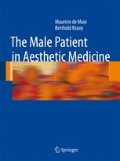Abstract
Like with peels – there is nothing like a laser. There ablative lasers and non ablative lasers – all of them requiring special attention. The chapter covers most of them and has a special focus on the newest technology: the fractional technology
Access this chapter
Tax calculation will be finalised at checkout
Purchases are for personal use only
References
Alam, M. and J. S. Dover (2003). “Nonablative laser and light therapy: an approach to patient and device selection.” Skin Therapy Lett 8(4): 4–7.
Alster, T. S. and E. L. Tanzi (2003). “Hypertrophic scars and keloids: etiology and management.” Am J Clin Dermatol 4(4): 235–243.
Apfelberg, D. B. (1997). “A critical appraisal of high-energy pulsed carbon dioxide laser facial resurfacing for acne scars.” Ann Plast Surg 38(2): 95–100.
Avram, D. K. and M. P. Goldman (2004). “The safety and effectiveness of single-pass erbium:YAG laser in the treatment of mild to moderate photodamage.” Dermatol Surg 30(8): 1073–1076.
Baumler, W., E. T. Eibler, et al (2000). “Q-switch laser and tattoo pigments: first results of the chemical and photophysical analysis of 41 compounds.” Lasers Surg Med 26(1): 13–21.
Carniol, P. J., J. Vynatheya, et al (2005). “Evaluation of acne scar treatment with a 1450-nm midinfrared laser and 30% trichloroacetic acid peels.” Arch Facial Plast Surg 7(4): 251–255.
Chajchir, A. and I. Benzaquen (2005). “Carbon dioxide laser resurfacing with fast recovery.” Aesthetic Plast Surg 29(2): 107–112.
Dierickx, C. C. (2006). “The role of deep heating for noninvasive skin rejuvenation.” Lasers Surg Med 38(9): 799–807.
Fleming, D. (1999). “Controversies in skin resurfacing: the role of erbium.” J Cutan Laser Ther 1(1): 15–21.
Goldberg, D. J. (2002). “Nonablative dermal remodeling: does it really work?” Arch Dermatol 138(10): 1366–1368.
Goldmann, A. (2006). “Submental Nd:Yag laser-assisted liposuction.” Lasers Surg Med 38(3): 181–184.
Gundogan, C., B. Greve, et al (2004). “Repigmentation of persistent laser-induced hypopigmentation after tattoo ablation with the excimer laser.” Hautarzt 55(6): 549–552.
Jacob, C. I., J. S. Dover, et al (2001). “Acne scarring: a classification system and review of treatment options.” J Am Acad Dermatol 45(1): 109–117.
Jaffe, B. H. and J. T. Walsh, Jr. (1996). “Water flux from partial-thickness skin wounds: comparative study of the effects of Er:YAG and Ho:YAG lasers.” Lasers Surg Med 18(1): 1–9.
Jaques, S. L. (1992). “Laser-tissue interactions. Photochemical, photothermal, and photomechanical.” Surg Clin North Am 72(3): 531–558.
Kim, K. H. (2006). “Laser lipolysis using a novel 1,064 nm Nd:YAG Laser.” Dermatol Surg 32(2): 241–248.
Kono, T., D. Manstein, et al (2006). “Q-switched ruby versus long-pulsed dye laser delivered with compression for treatment of facial lentigines in Asians.” Lasers Surg Med 38(2): 94–97.
Kuperman-Beade, M., V. J. Levine, et al (2001). “Laser removal of tattoos.” Am J Clin Dermatol 2(1): 21–25.
Liew, S. H. (2002). “Laser hair removal: guidelines for management.” Am J Clin Dermatol 3(2): 107–115.
Manstein, D., G. S. Herron, et al (2004). “Fractional photothermolysis: a new concept for cutaneous remodeling using microscopic patterns of thermal injury.” Lasers Surg Med 34(5): 426–438.
Narurkar, V. A. (2007). “Skin rejuvenation with microthermal fractional photothermolysis.” Dermatol Ther 20(Suppl 1): S10–S13.
No, D., M. McClaren, et al (2004). “Sebaceous hyperplasia treated with a 1450-nm diode laser.” Dermatol Surg 30(3): 382–384.
Olsen, E. A. (1999). “Methods of hair removal.” J Am Acad Dermatol 40(2 Pt 1): 143–155.
Peach, A. H., K. Thomas, et al (1999). “Colour shift following tattoo removal with Q-switched Nd-YAG laser (1064/532).” Br J Plast Surg 52(6): 482–487.
Prado, A., P. Andrades, et al (2006). “A prospective, randomized, double-blind, controlled clinical trial comparing laser-assisted lipoplasty with suction-assisted lipoplasty.” Plast Reconstr Surg 118(4): 1032–1045.
Ross, V., G. Naseef, et al (1998). “Comparison of responses of tattoos to picosecond and nanosecond Q-switched neodymium: YAG lasers.” Arch Dermatol 134(2): 167–171.
Sadick, N. and L. Sorhaindo (2005). “The radiofrequency frontier: a review of radiofrequency and combined radiofrequency pulsed-light technology in aesthetic medicine.” Facial Plast Surg 21(2): 131–138.
Taub, A. F. (2004). “Photodynamic therapy for the treatment of acne: a pilot study.” J Drugs Dermatol 3(Suppl 6): S10–S14.
Taylor, M. B. and I. Prokopenko (2006). “Split-face comparison of radiofrequency versus long-pulse Nd-YAG treatment of facial laxity.” J Cosmet Laser Ther 8(1): 17–22.
Touma, D., M. Yaar, et al (2004). “A trial of short incubation, broad-area photodynamic therapy for facial actinic keratoses and diffuse photodamage.” Arch Dermatol 140(1): 33–40.
Weiss, R. A., M. A. Weiss, et al (2006). “Monopolar radiofrequency facial tightening: a retrospective analysis of efficacy and safety in over 600 treatments.” J Drugs Dermatol 5(8): 707–712.
Author information
Authors and Affiliations
Corresponding author
Rights and permissions
Copyright information
© 2009 Springer-Verlag Berlin Heidelberg
About this chapter
Cite this chapter
de Maio, M. (2009). Lasers. In: The Male Patient in Aesthetic Medicine. Springer, Berlin, Heidelberg. https://doi.org/10.1007/978-3-540-79046-4_7
Download citation
DOI: https://doi.org/10.1007/978-3-540-79046-4_7
Published:
Publisher Name: Springer, Berlin, Heidelberg
Print ISBN: 978-3-540-79045-7
Online ISBN: 978-3-540-79046-4
eBook Packages: MedicineMedicine (R0)

